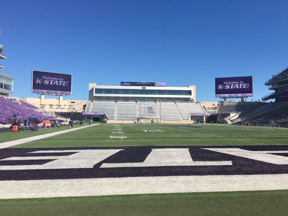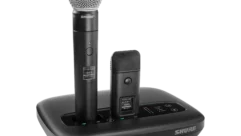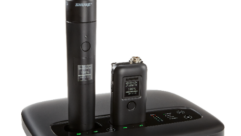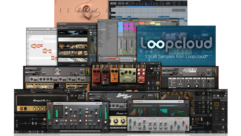
SVC Podcast – Show Notes – Show 180-2
In this edition of the SVC Podcast, Contributing Editor Bennett Liles talks with Ryan Kuzman from Daktronics Video Sales about the very recent video and sound upgrades to Bill Snyder Family Stadium at Kansas State University. Ryan outlines the timeline of the project and how the large new LED displays are controlled, adjusted for various lighting conditions and how quick maintenance can be done through front and back access on the LED display units.
Links of interest:
- Daktronics – Video Display Systems
- Daktronics Creative Services for Enhanced Dynamic Content
- Bill Snyder Family Stadium
Download Podcast Here:
https://s3.amazonaws.com/nb-svc/public/public/180-2_Daktronics_Kansas_St…
This is the SVC Podcast from Sound & Video Contractor Magazine with Ryan Kuzman of Daktronics. Show notes and equipment links for the podcast are on the web site of Sound & Video Contractor Magazine at svconline.com.
Kansas State University’s Bill Snyder Family Stadium got new video and sound systems recently and Daktronics was there to provide both of them. These were the crowning touches to a renovation project that’s been going on for years. Ryan Kuzman of Daktronics Video Sales is with us today to give us the story on the stadium’s new LED displays. Stay with us for the SVC Podcast.
Ryan, great having you here for the SVC Podcast from Daktronics where I know it’s a very busy time of year right now so thanks for taking the time to be with us. How have you been doing?
My pleasure, Bennett. Very busy right now. Been doing well.
Good to be busy. I would guess that the weather up there is okay this time of year but I would hate to be installing big outdoor video displays in the middle of a South Dakota winter where Daktronics is home based.
[Laughs] Yes. So yeah, this technically is normally our biggest time of the year, but our schedules our normally driven by particular sports or markets and what seasons they’re in. And obviously the weather tends to be a little bit sketchy in the wintertime in some areas, but fortunately the sports markets kind of determine when we install big projects such as stadiums and arenas. And most of those actually fall during the summer because their openers or first start games tend to be in the fall or just at the end of the fall so it works out pretty good. [Timestamp: 1:41]
By the fall you’ve probably gotten a lot of work done but that first game of the season is a hard deadline. Last week we were talking to John Olsen about the Bill Snyder Family Stadium at Kansas State University. That place seems to have been modernized beyond its own sound and video systems so they called you in for a big technical upgrade. What did you do on the video side of the project?
Well, whenever there’s modifications to facilities the size of Bill Snyder Family Stadium there’s usually potential changes in how content needs to be delivered. That includes not only audio but also other mediums of communication with the fans. And a lot of times that has to do with what we do at Daktronics as well, which is large LED displays. So any additional seating, large changes in the facility that can change the overall footprint to this stadium can affect the needs that things may need to be updated for fan engagement. [Timestamp: 2:34]
Well, let’s get into the details on this one and this is probably the first question anybody would ask but how big are the new displays? Are they in addition to what was already there or in place of it?
They’re actually in addition to what’s already there on the south side. So in the past two seasons previous we were able to do some work for them for some large video displays on the north end of the stadium there at K State. And then this season we’ll be installing, or have installed actually, two new displays that flank the existing video display on the south side. So this season will feature two new LED hustle stat displays that flank the video that are 91/2 feet tall by 26 feet wide, and there’s a pair of those. And then there will also be new field level boards, LED boards, measuring 31/2 feet tall by 24 feet wide that are located right behind the goalpost near the field. [Timestamp 3:24]
That’s a lot of heavy hardware to put in. Did you have to make any changes to the actual stadium structure? Of course there was a lot going on anyway but any structural changes to accommodate these big new displays?
Right. We didn’t actually. The hustle stat boards that we’ll be putting in are on the same stanchions or the same structure that they are currently on today. So we did some removal of some existing scoring system that was there and replaced it with these new LED displays. So there wasn’t really any changes that were required on that end. On the field level displays, Kansas State University and Bill Snyder Family Stadium were doing some renovations to that area already so they pretty much prepped that area for these two displays to go in. So they were already ready and prepped before we even got there. [Timestamp: 4:08]
That’s a lot of display structure. How much do these boards weigh?
The two upper hustle stat boards displays, those are about 2,600 pounds each. And the lower boards, the field level displays, are 960 pounds each. [Timestamp: 4:22]
A lot of hardware to haul in there. What kind of timeframe were you looking at just to get this part of it done?
As far as the timeframe, we normally ask customers for anywhere between 90 and 120 days from the time that the projects get kicked off to the time of completion. But in this case the order was placed in plenty of time and we were onsite for the whole installation – the audio and the new displays – for about a month. We were pretty much there the majority of March and we were completed in about 30 days. [Timestamp: 4:51]
Since there was so much work already going on were there a lot of other people to have to work around or did your guys pretty much have the run of the place while you were there?
Yeah, normally it would take about probably two weeks so we did have to wait for some construction to be done on the field level displays, so those were the last to go in. But we really weren’t affected by anything doing the audio system or the hustle stat boards. Those went up pretty quickly. We did have to wait for some electrical and things like that on the field level displays that were complete. [Timestamp: 5:20]
You mentioned the smaller boards down on the field level. What do they show on those?
That’s a good question. The field level boards will be completely up to whatever the customer wants to show. So I envision that they will probably be used primarily for some sponsorship content, but they’ll also be able to be used for other things like fan engagement items, messaging, captioning. They can be used for stats as well. So there’s a lot of delivery items they can be used for, but technically and futuristically I would say that sponsorship would be one of the primaries. [Timestamp: 5:51]
I know that even with the best equipment, things don’t always go a hundred percent right so if anything does go wrong with any of these displays how do you construct them so that you can do a quick fix on them?
That’s a great question. We actually construct our displays to be front or rear accessible so that they can be repaired or addressed either from the front or the back. So with these displays in particular all of the service work will be done on the fronts of the displays so each of those modules would pop out and you could do any service work necessary that’s needed to fix any issue that is occurring through the front side. So with the lift on the hustle displays, which they have onsite, we would be able to get up there fairly quickly and on the field level displays you really don’t need any other tools other than your hands. So very simple on the field. [Timestamp: 6:35]
Very handy because if something does go wrong you’re very short on time to get it fixed. Good to have them quick and easy to repair. And these are at the north end of the field?
These are all on the south end. The north end, it was the equipment that we put in, I think, in 2015 and ’16.
Okay, so you’re not talking about having direct sunlight on these displays on a game day.
No. The north end would get most of the sunlight, but even if the direct sun was a factor it’s not something that we consider as being a huge problem. We actually spend millions and millions of dollars annually on research and development to ensure our customers get every need they could ever want on game day. So when it comes to direct sunlight all of our displays have the ability to be adjusted higher or lower in brightness depending upon the natural light that’s needed. So if it’s a bright, sunshiny day they can be turned up to provide the higher brightness necessary to fight the sun, and on the evening or a cloudy day they can be dialed back to be not as bright for the fans as well. So really not an issue. We actually tailor made our displays not just for K State but for all of our customers to be able to handle the sunlight in a satisfactory manner. [Timestamp: 7:41]
Yeah, I wouldn’t think that it would occur to many people that at night these displays could actually be too bright but that would be a situation where you would have to able to adjust the brightness on it.
Absolutely.
How do you control these new displays? Did you have to put in new cabling or anything to allow control for them?
Yeah. So each of these displays require fiber cabling to be installed. So we did have to pull some fiber for the field level displays and also the hustle stat displays. The fiber cable is run from the display itself up to the control in the west press box where control is located and then our show control user stations are controlling all the displays in the entire facility. So the north end displays and the south end displays are all controllable by the show control user stations that we provide up there. [Timestamp: 8:28]
That must have to be a carefully planned and set up situation so that you have the right video on the right display at the right moment during a very high profile event.
Absolutely. And Kansas State University has some very qualified people up there that do a very good job of putting on a very quality show for their fans. So we provide K State with all the tools and they provide all the expertise on how to run the tools. [Timestamp: 8:52]
That was a lot of distance to cover on the cabling. What would be more heavy on the timeframe, the construction of the board itself or running all of that cable?
Actually, the cable was pretty easy as long as we have a conduit path which we always do at Kansas State. The cabling and the running of the cabling is actually pretty easy. The display installation takes a little bit longer because those displays are delivered in sections and they have to be lifted and held in place so that they are mounted correctly. So I would say that the more time-consuming portion is the displays themselves rather than the cable run. [Timestamp: 9:23]
And Daktronics products are always pre-assembled and tested at the factory before they ever go out the door.
Correct. Yes. We do all the quality control in Brookings, South Dakota. Obviously all American made in the USA and up there in Brookings. So everything is quality controlled by us. We test everything before it ships out. Like I said, display equipment do come in modular sections, but each of those is tested before they actually leave. [Timestamp: 9:46]
There was a whole lot to this installation. Lots of details. Were there any surprises along the way?
That’s another good question. I really can’t think of anything that was too shocking or big of a surprise. Things went pretty smooth overall. I think that there’s always some things that come up during an installation that can get you to scratch your head a little bit, whether it be a conduit path that’s blocked or a bolt section that doesn’t go in quite right. But we’ve had so much experience not only at K State, but at so many institutions all over the world that we’re getting pretty good at putting this stuff together. So even the smallest or medium-issue doesn’t have to be a big surprise to us. So I think in the end everything went very smooth. I’m very excited to see all the K State fan reaction to these new displays coming up this fall. I think it’s going to be great. [Timestamp: 10:35]
You mentioned at the beginning that this is the company’s busiest time of year. John Olsen was telling us last week that you have projects coming up at the University of Wisconsin, the University of Jamestown and Waco ESD Stadium so a lot of things coming up.
Yeah. There are several others. Some of them we aren’t able to release yet as far as customers not wanting us to release when they’re getting their products, but yes we’re very busy with several projects. John mentioned a few there. There’s several more that are coming up and we’re very excited to deliver on those customers as well. [Timestamp: 11:06]
Well it’s been good talking to you about this one. We got audio details last week and now we have the story behind the video side of it at Kansas State University’s Bill Snyder Family Stadium. Ryan Kuzman from Daktronics Video Sales. It’s good of you to get with us during this very busy time of year.
My pleasure, Bennett.
Thanks for getting with us on today’s SVC Podcast. Show notes and equipment links are on the website of Sound & Video Contractor Magazine at svconline.com. Next week we’ll have a brand new show so we’ll see you then on the SVC Podcast.










